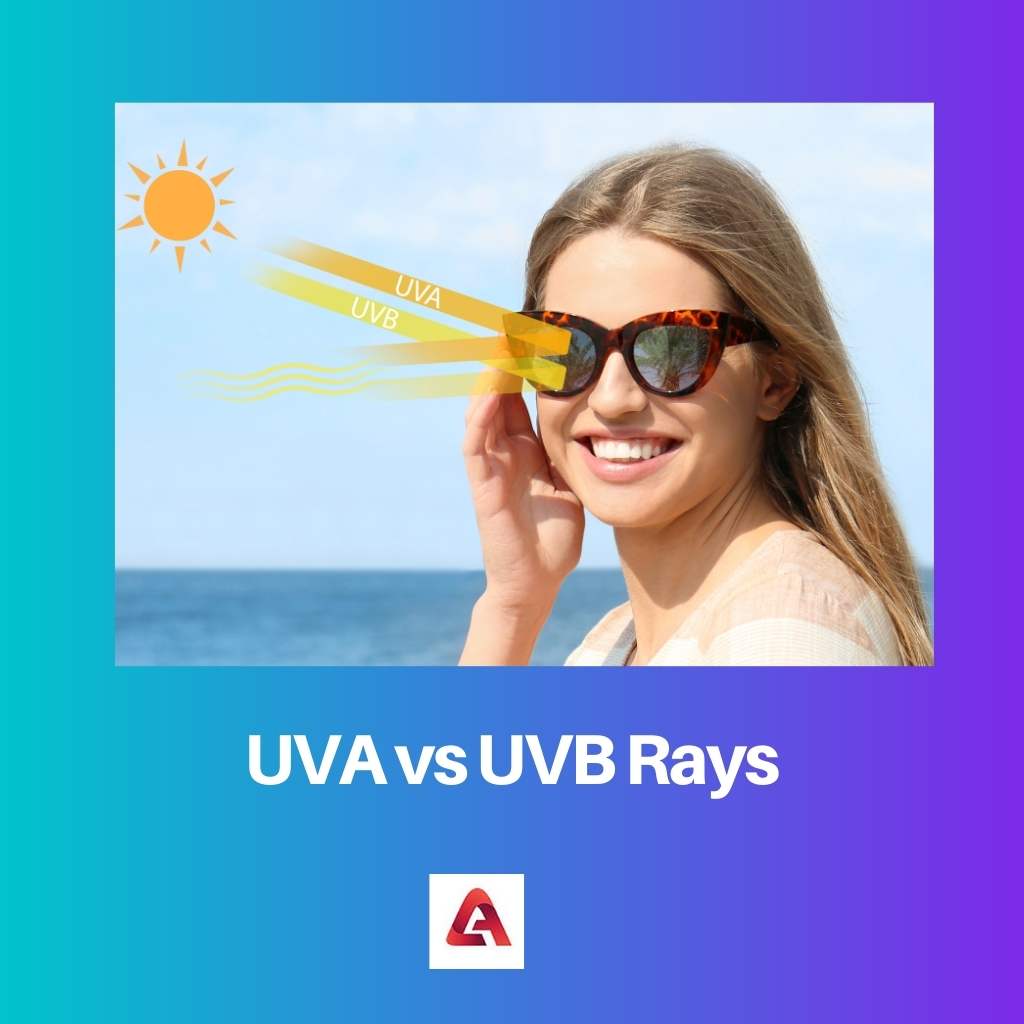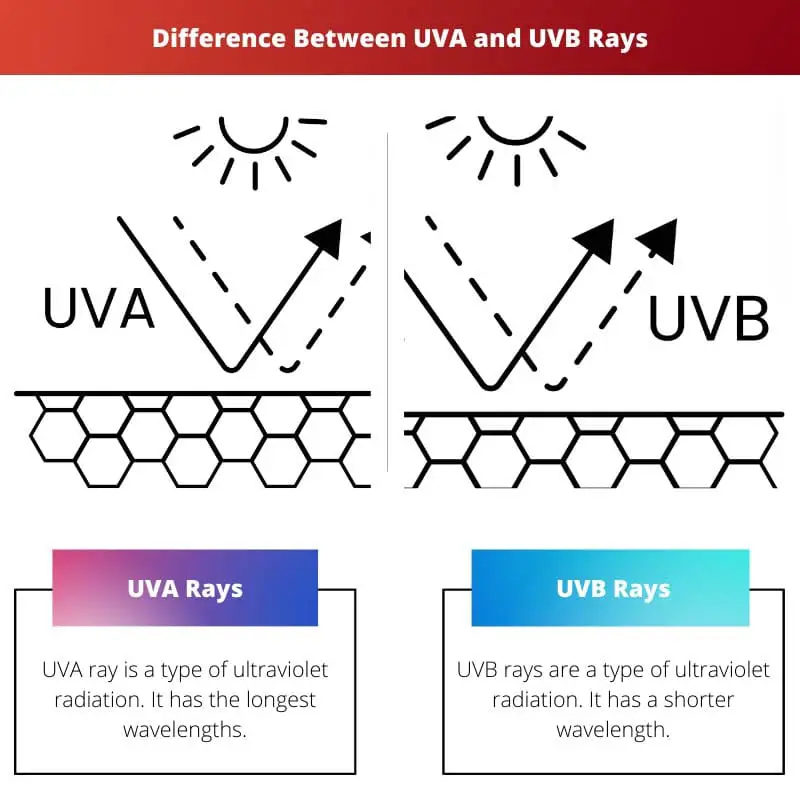The sun is the main source of energy. It has ultraviolet radiation or UV rays in it. Ultraviolet rays are a form of electromagnetic radiation. Most of the ultraviolet radiation from the sun is filtered by the atmosphere.
These rays have several chemical and biological effects. The two types of ultraviolet rays are UVA rays and UVB rays.
Key Takeaways
- UVA rays have longer wavelengths, penetrate deeper into the skin, and contribute to skin ageing.
- UVB rays have shorter wavelengths, cause sunburns, and increase the risk of skin cancer.
- Sunscreen products should provide broad-spectrum protection to shield against UVA and UVB rays.
UVA vs UVB Rays
The difference between UVA and UVB rays is that UVA rays are long waves of ultraviolet radiation, while UVB rays are short waves of ultraviolet radiation. The energy levels of the UVA rays are higher, while that of the UVB rays are lower.

UVA rays are the main cause of skin aging. UVA rays have a higher power of penetration. It can reach the deep layers of the skin. The effects on the skin by UVA rays are immediate and rapid.
It cannot be filtered through clouds or the atmosphere and is the main constituent of the ultraviolet radiation that reaches the earth’s surface.
While UVB rays are the main cause of skin burning, UVB rays have a lower power of penetration when compared to UVA rays. It can affect only the outer layers of the skin and can have long-term severe complications.
It cannot pass through windows and is absorbed partially by the atmosphere of the earth.
Comparison Table
| Parameters of Comparison | UVA rays | UVB rays |
|---|---|---|
| Wavelengths | It has longer wavelengths | It has shorter wavelengths |
| Intensity | UVA rays are intense | UVB rays are less intense |
| Penetration power | UVA can penetrate the inner layers of the skin and reach the dermis | UVB rays can penetrate only till the top later of the skin |
| Benefits | Used in tanning beds and have the potential to improve mood and increase energy | Produces Vitamin D and Vitamin D3 |
| Effects | Immediate tanning, sunburn, premature aging and wrinkles, genetic damage | Delayed tanning, blistering, photoaging, and skin cancer |
What is UVA Rays?
UVA ray is a type of ultraviolet radiation. It has the longest wavelengths. Due to the longer wavelengths, it can penetrate deeper into the skin and reach the middle layer of the skin, called the dermis.
95% of the sun’s UV rays that reach the earth are UVA rays.
The high penetration power of UVA rays can damage the skin cells deeply. The rays can even penetrate windows and clouds. There have been cases of indirect damage to the DNA due to prolonged exposure to UVA rays.
Premature signs of aging, like wrinkles and fine lines, can occur due to UVA rays. There is no direct evidence of skin cancer due to exposure to UVA rays.
The main source of UVA rays is sunlight and tanning beds. UVA rays are not absorbed by the ozone. Most of the ultraviolet radiation that reaches the earth’s surface is UVA rays.
Most of the effects of UVA rays are immediate and rapid, like sunburn or immediate tanning.
UVA rays are found in the sunlight all around the year. It does not change its intensity upon a change in altitude or weather. It is present in the sunlight 500 times more than UVB rays. It has long-term damage to the skin.
What is UVB Rays?
UVB rays are a type of ultraviolet radiation. It has a shorter wavelength. It has the potential to reach the outer layer of the skin, which is called the epidermis.
Most of the UVB rays emitted by the sun are absorbed by the atmosphere. 5% of the sun’s UV rays that reach the earth are UVB rays.
Though UVB rays have shorter wavelengths, it has higher levels of energy. It has the potential to damage only the outer layers of the skin as it lacks deep penetration power.
There have been several cases where UVB rays have directly damaged the DNA and caused alterations.
The most dreadful effect of UVB rays is that they can cause skin cancer. It also can lead to premature aging of the skin. Most of the effects of UVB rays are delayed and appear hours later after sun exposure.
The highest amount of UVB rays are found in higher altitudes and near the equatorial region.
Most of the UVB rays are absorbed by the atmosphere of the earth. Some partially absorbed rays reach the earth’s surface. UVB rays are also filtered by the clouds.
Upon exposure to UVB rays, the skin can produce Vitamin D (mainly in the form of Vitamin D3).
Main Differences Between UVA Rays and UVB Rays
- UVA rays have longer wavelengths, while UVB rays have shorter wavelengths.
- UVA rays have lower levels of energy, while UVB rays have higher energy levels.
- The sunlight contains 95% UVA, while the concentration of UVB rays is 5% in the sunlight when it reaches the earth’s surface.
- UVA rays can penetrate deep into the skin and cause premature skin aging, and photoaging, while UVB rays can penetrate the top layer and cause sunburn and skin cancer.
- UVA rays are not absorbed by the atmosphere or ozone, while most of the UVB rays are absorbed by the atmosphere of the earth.




